Motto of the query is very simple, to find out the last entry on a foreign key column. the pseudo code I can say is
select vehicleid , last_journey_point , last_journey_time from journeyTable.
here is my SQL statement
-- loconumber is a indexed column -- journeyserla is a autonumber primary key int(11) -- the table locojourney contains 400,000 records
-- the below block of code executes in 19 secs
with LocomotiveLastRun AS(
-- this block of code runs in 0.016 sec
SELECT locojourney.loconumber , MAX(locojourney.journeyserla) as lastrunid
FROM locojourney GROUP BY loconumber)
SELECT locojourney.CurrentCombiners , locojourney.JourneySerla ,
locojourney.From_RunPoint , locojourney.NEXT_RunPoint
FROM LocomotiveLastRun FORCE INDEX(lastrunid)
JOIN locojourney FORCE INDEX(PRIMARY) ON x.lastrunid = locojourney.journeyserla
WHERE locojourney.ishoc = 'n'
the EXPLAIN command shows a derived table which is using no index and using where and type ALL
This is the table definition:
-- SHOW CREATE TABLE locojourney
CREATE TABLE `locojourney` (
`trainID` smallint(5) NOT NULL,
`LocoNumber` varchar(5) CHARACTER SET latin1 COLLATE latin1_swedish_ci NOT NULL,
`CurrentLocoBase` varchar(10) CHARACTER SET latin1 COLLATE latin1_swedish_ci DEFAULT NULL,
`CurrentDuedate` date DEFAULT NULL,
`LocoConsist` varchar(10) CHARACTER SET latin1 COLLATE latin1_swedish_ci NOT NULL,
`CurrentLocoDomain` varchar(10) CHARACTER SET latin1 COLLATE latin1_swedish_ci DEFAULT NULL,
`DomainChange` varchar(10) CHARACTER SET latin1 COLLATE latin1_swedish_ci NOT NULL,
`FEDR` enum('N','Y') CHARACTER SET latin1 COLLATE latin1_swedish_ci DEFAULT 'N',
`LADR` enum('N','Y') CHARACTER SET latin1 COLLATE latin1_swedish_ci DEFAULT 'N',
`ISBANKER` enum('N','Y') CHARACTER SET latin1 COLLATE latin1_swedish_ci DEFAULT 'N',
`TrainName` varchar(10) CHARACTER SET latin1 COLLATE latin1_swedish_ci NOT NULL,
`WithOutLoad` enum('N','Y') CHARACTER SET latin1 COLLATE latin1_swedish_ci NOT NULL DEFAULT 'N',
`runRoute` varchar(50) CHARACTER SET latin1 COLLATE latin1_swedish_ci NOT NULL,
`From_RunPoint` varchar(10) CHARACTER SET latin1 COLLATE latin1_swedish_ci NOT NULL,
`From_RunTime` datetime NOT NULL,
`NEXT_RunPoint` varchar(10) CHARACTER SET latin1 COLLATE latin1_swedish_ci NOT NULL,
`NEXT_RunTime` datetime NOT NULL,
`Affects_Outage` enum('N','Y') CHARACTER SET latin1 COLLATE latin1_swedish_ci DEFAULT 'N',
`Affects_Mileage` enum('N','Y') CHARACTER SET latin1 COLLATE latin1_swedish_ci DEFAULT 'N',
`GroundDistance` double(5,2) DEFAULT '0.00',
`SHGallowance` int(11) DEFAULT '0',
`Outage` double(5,4) DEFAULT '0.0000',
`UnderServiceType` enum('FHT','CHG','DEP','MIX','DETN') CHARACTER SET latin1 COLLATE latin1_swedish_ci NOT NULL DEFAULT 'FHT',
`SubServiceHead` varchar(25) CHARACTER SET latin1 COLLATE latin1_swedish_ci NOT NULL DEFAULT 'RUN',
`IShoc` enum('N','Y') CHARACTER SET latin1 COLLATE latin1_swedish_ci DEFAULT 'N',
`CurrentCombiners` varchar(28) CHARACTER SET latin1 COLLATE latin1_swedish_ci DEFAULT NULL,
`RunSetSerla` varchar(25) CHARACTER SET latin1 COLLATE latin1_swedish_ci DEFAULT NULL,
`JourneySerla` int(11) NOT NULL AUTO_INCREMENT,
`NominationSerla` varchar(50) CHARACTER SET latin1 COLLATE latin1_swedish_ci DEFAULT NULL,
`Traction` enum('DSL','AC') CHARACTER SET latin1 COLLATE latin1_swedish_ci NOT NULL DEFAULT 'DSL',
`Trainload` smallint(4) NOT NULL DEFAULT '0',
`LeadAssist` enum('Y','N') CHARACTER SET latin1 COLLATE latin1_swedish_ci NOT NULL DEFAULT 'N',
`DEO` varchar(100) CHARACTER SET latin1 COLLATE latin1_swedish_ci DEFAULT NULL,
`DEOtime` timestamp NULL DEFAULT CURRENT_TIMESTAMP ON UPDATE CURRENT_TIMESTAMP,
PRIMARY KEY (`JourneySerla`),
KEY `trainID` (`trainID`) USING BTREE,
KEY `routesection_idx` (`runRoute`) USING BTREE,
KEY `loconumber_idx` (`LocoNumber`) USING BTREE,
KEY `runsetserla_idx` (`RunSetSerla`) USING BTREE,
KEY `subservicehead_idx` (`SubServiceHead`) USING BTREE,
CONSTRAINT `locojourney_ibfk_1` FOREIGN KEY (`SubServiceHead`) REFERENCES `ineffective` (`IneffectiveHead`) ON UPDATE CASCADE,
CONSTRAINT `locojourney_ibfk_3` FOREIGN KEY (`runRoute`) REFERENCES `routesections` (`Sectionname`) ON DELETE RESTRICT ON UPDATE CASCADE,
CONSTRAINT `loconumber_fk` FOREIGN KEY (`LocoNumber`) REFERENCES `lococontainer` (`LocoNumber`) ON DELETE CASCADE ON UPDATE CASCADE
) ENGINE=InnoDB AUTO_INCREMENT=345719 DEFAULT CHARSET=utf8mb4 COLLATE=utf8mb4_0900_ai_ci
